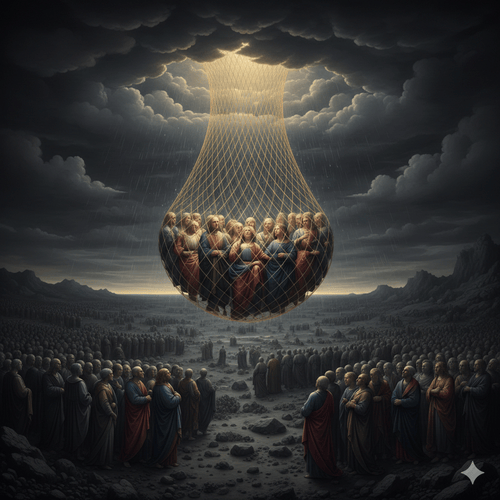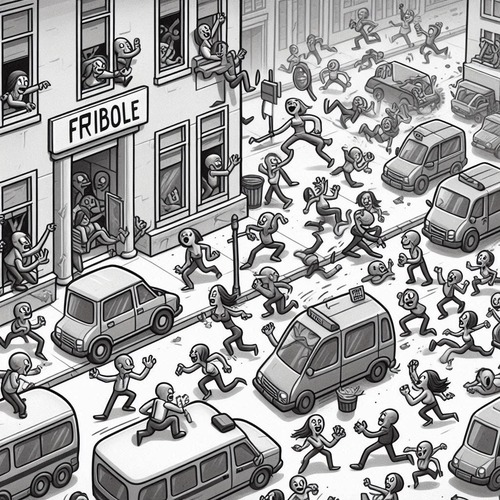Satan’s Final Defeat: Reformed Perspectives on Revelation 20
Throughout Scripture, we encounter a formidable adversary—Satan, the devil, the accuser of the brethren. From the Garden of Eden to the apocalyptic visions of Revelation, the fallen angel works tirelessly against God’s purposes and people. Yet the Bible is clear: Satan’s days are numbered. His defeat was sealed at the cross, and his final judgement is certain.
But what exactly does Scripture teach about Satan’s binding and ultimate fate? Popular culture often presents a confused picture of the devil’s current status and future judgement. Is Satan already bound, or is this entirely future? What does Revelation 20 mean when it speaks of a “thousand years”? And what will Satan’s final judgement look like?
SATAN’S IDENTITY AND CURRENT ACTIVITY
Before we can understand Satan’s ultimate fate, we must grasp who he is and his current role in God’s creation.
- A created being: Scripture reveals Satan as a created being—a fallen angel who rebelled against the Creator. Prophets Isaiah and Ezekiel provide glimpses of the fall in passages that transcend earthly kings to describe a spiritual rebellion (Isaiah 14:12-15; Ezekiel 28:12-19).
- ‘Ruler’ of this world: The New Testament identifies Satan as “the ruler of this world” (John 12:31, 14:30, 16:11) and “the god of this age” who “has blinded the minds of unbelievers” (2 Corinthians 4:4). Peter warns believers “Your adversary the devil prowls around like a roaring lion, seeking someone to devour” (1 Peter 5:8).
- Under God’s sovereign watch: Yet Satan’s power is limited and derivative. He is not the equal opposite of God, as in dualism, but a creature under God’s sovereign control. As Luther famously wrote, the devil is “God’s devil”—even his malevolent actions ultimately serve God’s purposes, as seen in the book of Job.
This raises an important question: How do we reconcile Satan’s real but limited authority as “prince of this world” with the biblical teaching about his binding? This question brings us to one of the most debated passages in Scripture—Revelation 20.
THE BINDING OF SATAN IN REDEMPTIVE HISTORY
Revelation 20:1-3 describes a dramatic scene. The Reformed tradition, particularly in its amillennial expression, has generally interpreted this passage as describing Satan’s current binding during the church age, rather than a future literal 1000-year period. This binding began with Christ’s first coming and will continue until His return.
Other texts on the binding: Jesus Himself alluded to this binding in Matthew 12:29. Christ came to bind the “strong man” (Satan) and plunder his house by freeing those under his power. The decisive moment of this binding occurred at the cross (Colossians 2:15). The author of Hebrews explains that through death, Jesus destroyed “the one who has the power of death, that is, the devil” (Hebrews 2:14).
What, then, does this binding mean? Revelation 20 provides the answer: Satan is bound “so that he might not deceive the nations any longer.” Before Christ’s coming, most nations remained in darkness, with only Israel having God’s special revelation. But after Pentecost, the gospel began spreading to all nations. The Great Commission became possible because Satan could no longer keep the nations in complete deception.
No, this doesn’t mean Satan is inactive. Rather, his power to deceive the nations universally has been restricted. The gospel can now advance to every corner of the earth—something impossible when Satan had free reign. As Reformed theologian Anthony Hoekema wrote, “Satan is bound in the sense that he cannot prevent the spread of the gospel to all nations.”
This binding is evident in history. Before Christ, idolatry and paganism dominated the world. After Christ’s victory and the outpouring of the Spirit, the gospel steadily advanced across continents and cultures. While Satan still works actively to oppose the church, he cannot prevent the fulfillment of Christ’s promise in Matthew 24:14.
SATAN’S FINAL RELEASE AND DECEPTION
Revelation 20:7-9 describes a brief period when Satan will be released from his binding. Amillennialists interpret this to mean a final rebellion at the end of the church age, just before Christ’s return. Satan will be permitted one last attempt to overthrow God’s kingdom by gathering the nations (symbolically called “Gog and Magog,” drawing on Ezekiel’s prophecy) against the church.
Reformed interpreters have typically understood this as a period of intense persecution and apostasy. As Herman Bavinck wrote, “Before the end there will be one more terrible outbreak of the power of sin.” This aligns with Paul’s teaching in 2 Thessalonians 2:3.
Why would God allow such a devastating final deception? Here Reformed theology emphasises God’s sovereign purposes. The final rebellion will demonstrate that despite all the blessings of common grace and the wide proclamation of the gospel, the human heart apart from special grace remains opposed to God. It will also set the stage for Christ’s glorious return and the final vindication of His church.
The outcome of this rebellion is never in doubt. Before Satan’s forces can achieve victory, “fire came down from heaven and consumed them” (Revelation 20:9). The battle ends before it truly begins—a powerful testament to God’s sovereign control over even the most chaotic events of history.
THE FINAL JUDGEMENT OF SATAN
After the final rebellion is crushed, Satan faces his ultimate judgement (Revelation 20:10). This verse leaves no ambiguity about Satan’s fate. Unlike popular depictions of Satan ruling in hell, Scripture reveals hell (the lake of fire) is his place of punishment, not his kingdom. The devil will not torment others there; he himself will be tormented.
This punishment is eternal and conscious. The phrase “day and night forever and ever” (literally, “unto the ages of the ages” in Greek) is the strongest expression of endless duration in the New Testament. The same language is used to describe God’s eternal existence (Revelation 4:10) and the eternal blessedness of the saints (Revelation 22:5).
Satan will not face this judgement alone. Jesus spoke of “the eternal fire prepared for the devil and his angels” (Matthew 25:41), indicating the demonic forces will all share in their leader’s fate. Paul assures believers God will soon “crush Satan under your feet” (Romans 16:20), fulfilling the protoevangelium of Genesis 3:15 where God promised the serpent’s head would be crushed.
The judgement of Satan represents the final fulfillment of Christ’s victory (1 Corinthians 15:25-26). Satan’s power will be completely and permanently broken.
CONCLUSION: SATAN’S FINAL DEFEAT
The Reformed understanding of Satan’s binding and judgement offers a scripturally faithful perspective that avoids sensationalism while maintaining the real spiritual battle believers face. Satan is a defeated foe—bound by Christ at His first coming and destined for eternal judgment at His return.
This understanding shapes how we view history, salvation, and spiritual conflict. The gospel advances not because Satan allows it but because Christ has bound the foe. The final rebellion will come not because God loses control but because He temporarily permits Satan one last defeated attempt. And Satan’s judgment is certain not because good naturally triumphs over evil but because God has ordained it from before the foundation of the world.
For believers, this doctrine brings profound comfort. As we face spiritual opposition and witness evil in the world, we’re confident Satan’s days are numbered. The ancient serpent who deceived our first parents will be decisively and eternally judged. In the new creation, where righteousness dwells, Satan will have no place—only the glorious presence of God and the Lamb.
The story of redemption, from Genesis to Revelation, moves inexorably toward this final defeat of evil. And in that defeat, as in all things, soli Deo gloria—to God alone be the glory.
SATAN’S FINAL DEFEAT: RELATED FAQs
How does Satan’s final defeat demonstrate God’s absolute sovereignty over evil? Satan’s binding and judgement demonstrate even the adversary operates within the boundaries God has established. Satan isn’t an independent force but a creature whose rebellious actions occur within God’s permissive will and ultimately serve His purposes. As Scripture reveals, Satan needed God’s permission to afflict Job (Job 1:12), and Jesus told Peter that Satan had “demanded to sift you like wheat” (Luke 22:31)—indicating the devil’s need for divine permission. The timing of Satan’s binding, his temporary release, and his final judgement are all determined not by Satan himself but by God’s sovereign decree.
- How does Satan’s final defeat highlight the completeness of Christ’s redemptive work? The binding and judgement of Satan reveal Christ’s redemption extends far beyond individual salvation to encompass cosmic restoration. Jesus explicitly stated He came to “destroy the works of the devil” (1 John 3:8). Defeating Satan was central to His mission. At the cross, Christ “disarmed the rulers and authorities and put them to open shame, by triumphing over them” (Colossians 2:15), securing a decisive victory over satanic powers. This binding allows the gospel to advance to all nations, fulfilling God’s promise to Abraham that in his offspring all nations would be blessed. Satan’s final defeat represents the complete fulfillment of the protoevangelium in Genesis 3:15, where God promised the serpent’s head would be crushed by the woman’s offspring—meaning Christ.
- How does Satan’s binding and judgement correct our understanding of salvation history? The Reformed understanding of Satan’s final defeat maintains the crucial “already but not yet” tension in salvation history that corrects both extremes of under-realised and over-realised eschatology. Some Christians act as though Satan still has his full pre-cross power, living in fear as if Christ’s victory were merely future. Others speak as though Satan has no current influence at all, denying the reality of spiritual warfare. Reformed theology affirms that Satan is indeed “bound” since Christ’s first coming (Revelation 20:2-3) specifically so “that he might not deceive the nations”—which explains how the gospel can now advance globally. Yet this binding is limited; Satan still “prowls around like a roaring lion” (1 Peter 5:8) within the boundaries God has established. This balanced view places us properly in redemptive history—living between Christ’s two comings, enjoying the firstfruits of His victory while anticipating its consummation.
- How does Satan’s final defeat provide assurance to believers facing spiritual warfare? For believers engaged in spiritual warfare, Satan’s binding and certain judgement provide profound assurance that we fight from victory, not for victory. Christians need not fear Satan as though he were God’s equal; he is a defeated foe operating on a leash. Jesus has already “destroyed the one who had the power of death, that is, the devil” (Hebrews 2:14), breaking his ultimate weapon. When we resist the devil, he must flee (James 4:7)—not because of our strength but because Christ’s authority backs our resistance. Paul assures believers that “the God of peace will soon crush Satan under your feet” (Romans 16:20), connecting our spiritual victories to Christ’s ultimate triumph. Even Satan’s fiercest attacks cannot separate us from God’s love (Romans 8:38-39).
How does Satan’s binding and judgement glorify God? Satan’s final defeat glorifies God by showcasing His perfect attributes throughout redemptive history. God’s wisdom is displayed in using even Satan’s rebellion to serve divine purposes—bringing greater glory than if sin had never entered creation. His justice shines forth as Satan receives exactly what his rebellion deserves, demonstrating that no creature can defy God with impunity. God’s mercy toward believers appears all the more brilliant against the backdrop of Satan’s judgment, highlighting the difference between vessels of wrath and vessels of mercy (Romans 9:22-23). His faithfulness is revealed in fulfilling the first gospel promise of Genesis 3:15 across millennia of redemptive history. God’s sovereignty is magnified as the one who sought to usurp divine prerogatives is cast into the lake of fire, proving that all creatures will ultimately glorify God—either willingly through worship or unwillingly through judgement.
SATAN’S FINAL DEFEAT: OUR RELATED POSTS
Editor's Pick

Why Do People Hate the Doctrine of Election?
…WHEN THEY REALLY SHOULDN’T Few Bible doctrines provoke stronger reactions than election. The idea that God chose some for salvation [...]

The Doctrine of Providence: Does God Really Govern All Things?
You’re sitting in the doctor’s office when the diagnosis lands like a thunderclap. Your mind races: Why this? Why now? [...]

No Decay, No Defeat: What It Means That Christ’s Body Saw No Corruption
On the Day of Pentecost, Peter stood before thousands and made a startling claim: David's body decayed in the tomb, [...]
SUPPORT US:
Feel the Holy Spirit's gentle nudge to partner with us?
Donate Online:
Account Name: TRUTHS TO DIE FOR FOUNDATION
Account Number: 10243565459
Bank IFSC: IDFB0043391
Bank Name: IDFC FIRST BANK






